School Consolidation Documents Table of Contents
- 07-14-10 Southern Echo chart on Student Race and Poverty Characteristics of School District Targeted and Not Targeted for Consolidation Based on Augenblick’s School Consolidation Criteria
- 07-19-10 Southern Echo map on 2008-2009 MS School District QDI Rankings, Enrollments and Expenditures – Map #2 – Complete Data Show Many More Districts Meet “Target” Criteria than Reported; One Does Not
- Map of 2008-2009 MS School District QDI Rankings, Enrollment, and Expenditures
- Table of 2008-2009 MS School District QDI Rankings, Enrollment, and Expenditures
- “Analysis of the Jan. – March 2010 meetings of the Governor’s Commission on Education Structure”, a compilation by Southern Echo
- “School District Achievement Gaps in Student Performance with the State Accountability Assessment Categories that are Linked to Race, Poverty and Disability, a Data-Driven Research-Based Analysis”, by Dr. Jerry Johnson and Shane Shope, M.Ed., a presentation by Southern Echo, Inc. and the Mississippi Delta Catalyst Roundtable
- “Understanding school consolidation policy: An analysis of inference to be drawn ambien online us pharmacy based on the evidence buy ambien online cheap that has been provided and that has not been provided to the Commission”, A presentation by Southern Echo and the Mississippi Delta Catalyst Roundtable to the Commission at a public hearing on May 3, 2010
- 04-02-10 Southern Echo and MS Delta Catalyst Roundtable Report to the Governor’s Commission on MS Educational Structure (ie school consolidation)
- 10-22-08 Marty Strange, Rural Schools and Community Trust — Presentation on School Consolidation
- 03-01-02 Dr. Jerry Johnson, Rural Schools and Community Trust – Small Works in Arkansas
- March 2002 – Dr. Jerry Johnson, Rural Schools and Community Trust – Small Works in Arkansas – How Poverty and the Size of Schools and School Districts Affect School Performance in Arkansas
- 2005 Rural Schools and Community Trust – The Impact on Race of School Consolidation in ARKANSAS – FULL REPORT
- 2005 Rural Schools and Community Trust – The Impact on Race of School Consolidation in ARKANSAS – SUMMARY
- 2006 Rural Schools and Community Trust – The Impact in ARKANSAS of Forced School Consolidation – FULL REPORT
- 2006 Rural Schools and Community Trust – The Impact in ARKANSAS of Forced School Consolidation – SUMMARY
- August 2006 – Lorna Jimerson, Ed.D, Rural Schools and Community Trust, “Why Small Works in Public Schools” – FULL REPORT
- Sept. 5, 2006 – Lorna Jimerson, Ed.D, Rural Schools and Community Trust, “Why Small Works in Public Schools” – SUMMARY OF REPORT
School Consolidation Documents
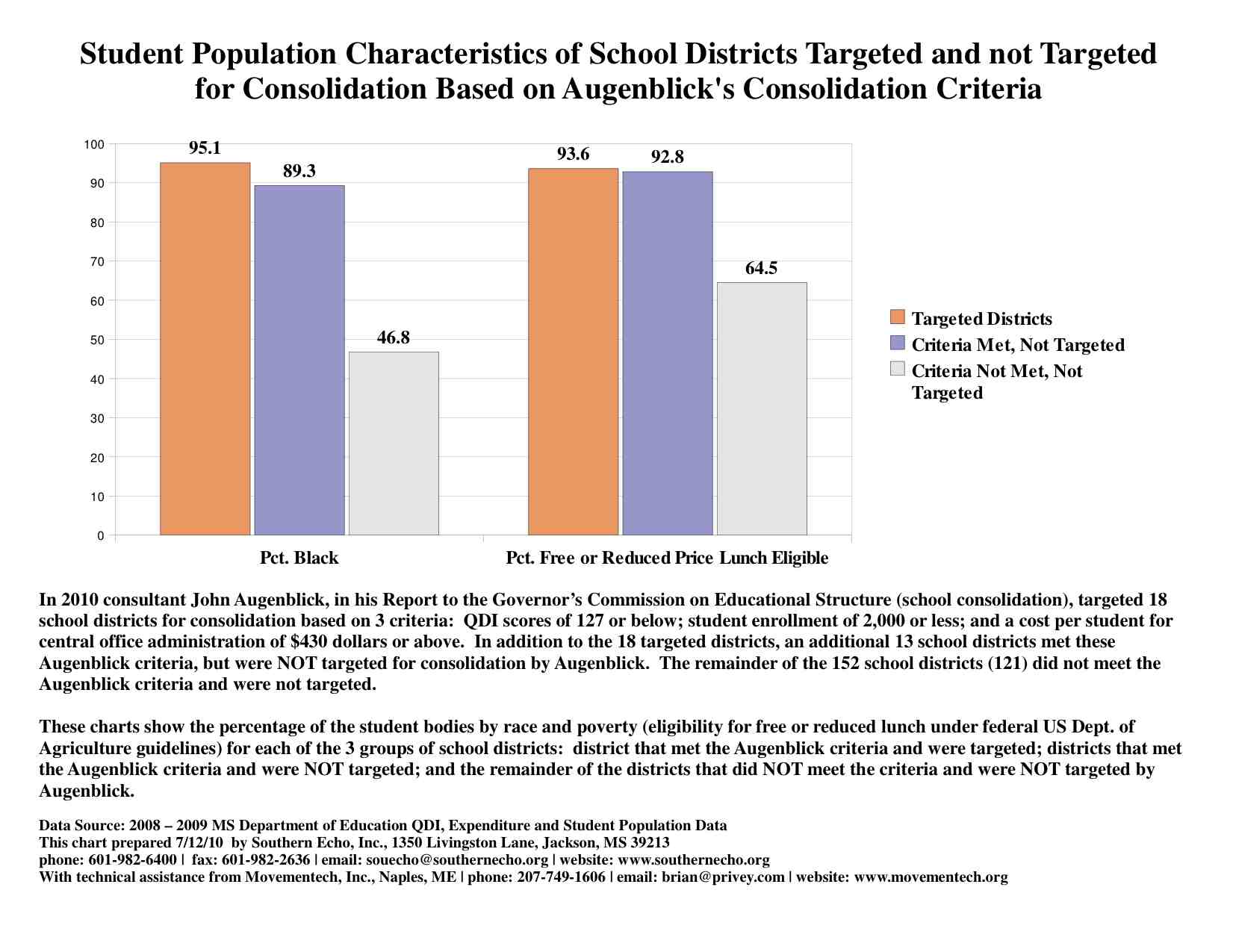 |
07-14-10 Southern Echo chart on Student Race and Poverty Characteristics of School District Targeted and Not Targeted for Consolidation Based on Augenblick’s School Consolidation Criteria This chart shows the percentage of students who are African American and the percentage of students eligible for free and reduced lunch (US Dept. of Agriculture measure of student poverty) in school districts that met the criteria used by the consultant for the Governor’s Commission on Educational Structure (school consolidation) to targets school districts for consolidation, in the school districts that met the criteria but were NOT targeted for consolidation, and the school districts that did NOT meet the criteria and were NOT targeted for consolidation. |
 |
07-19-10 Southern Echo map on 2008-2009 MS School District QDI Rankings, Enrollments and Expenditures – Map #2 – Complete Data Show Many More Districts Meet “Target” Criteria than Reported; One Does Not This map shows the Quality Distribution Index (QDI) scores, the QDI Rankings, the student enrollments and the cost per student of central office administrative expenses for 149 Mississippi school district (but not for the Agricultural High Schools). The map also identifies each of the 18 school districts that were targeted for consolidation by Augenblick & Palaich, the consultants to the Governor’s Commission on School Consolidation, and each of the 12 school districts that met the Augenblick criteria but were NOT targeted for consolidation. |
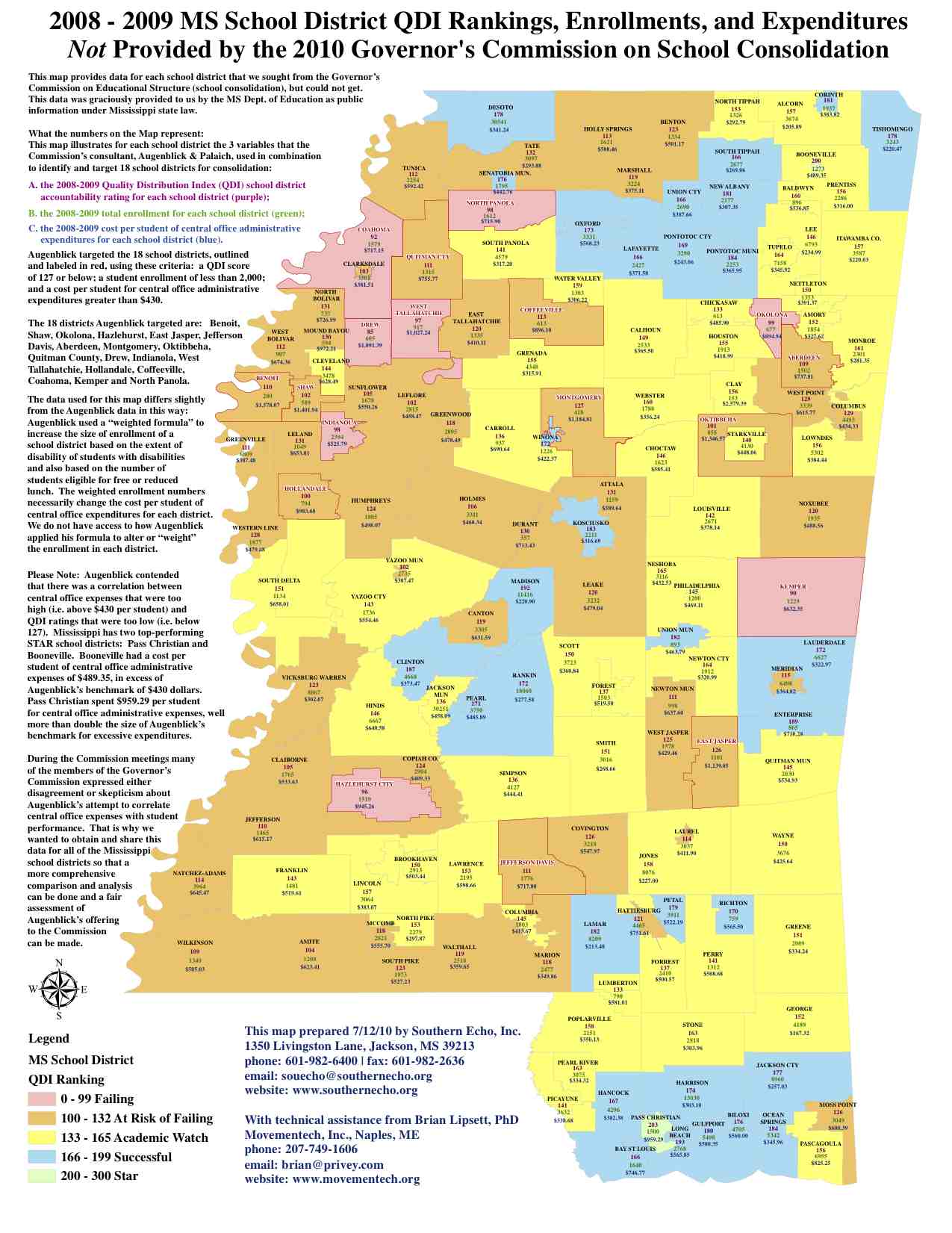 |
Map of 2008-2009 MS School District QDI Rankings, Enrollments, and Expenditures This map shows the QDI rankings, the enrollments, and the cost per student of central office expenses for the 2008-2009 school year, which is the same year used by Augenblick in his report. Augenblick used this data to target 18 school districts and some members of the Governor’s Commission continue to urge consideration of this data as a basis for targeting school districts for consolidation. |
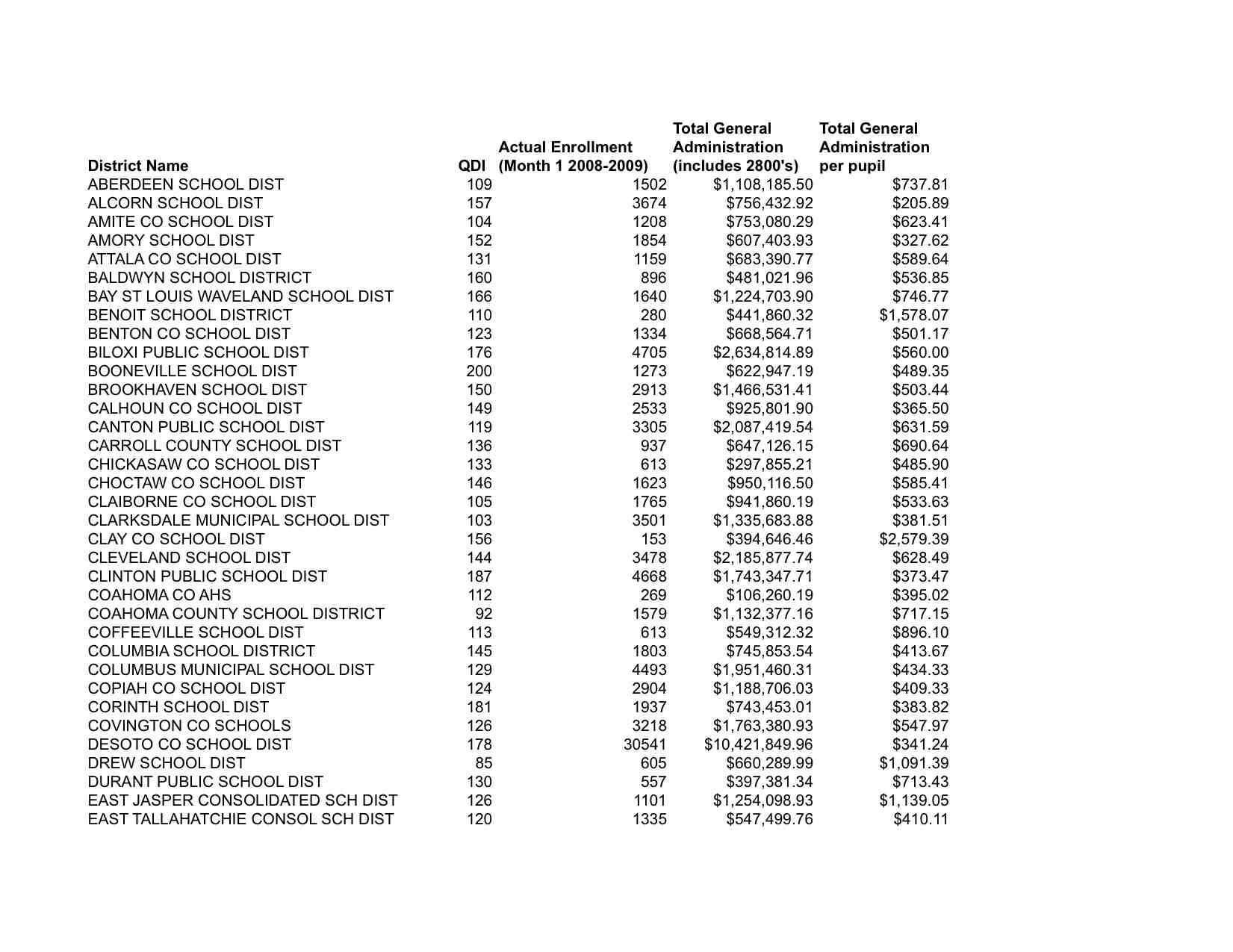 |
Table of 2008-2009 MS School District QDI Rankings, Enrollments, and Expenditures This table shows the QDI rankings, the enrollments, and the cost per student of central office expenses for the 2008-2009 school year, which is the same year used by Augenblick in his report. Augenblick used this data to target 18 school districts and some members of the Governor’s Commission continue to urge consideration of this data as a basis for targeting school districts for consolidation. |
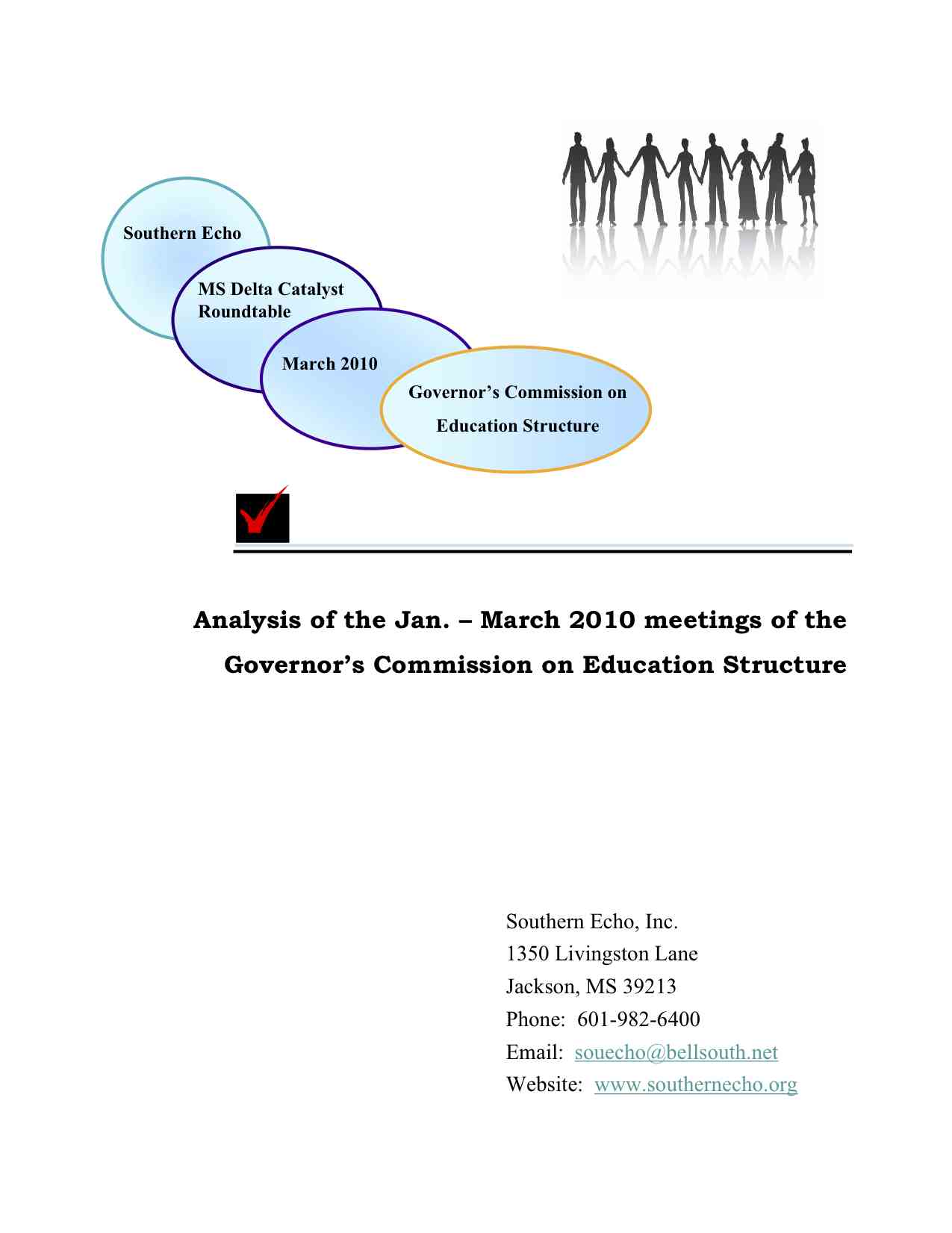 |
“Analysis of the Jan. – March 2010 meetings of the Governor’s Commission on Education Structure”, a compilation by Southern Echo These analyses by Southern Echo of what transpired at each of the meetings from January through March 2010 of the Governor’s Commission on Educational Structure are accompanied by the materials presented to the Commission by its consultant, Augenblick & Palaich. |
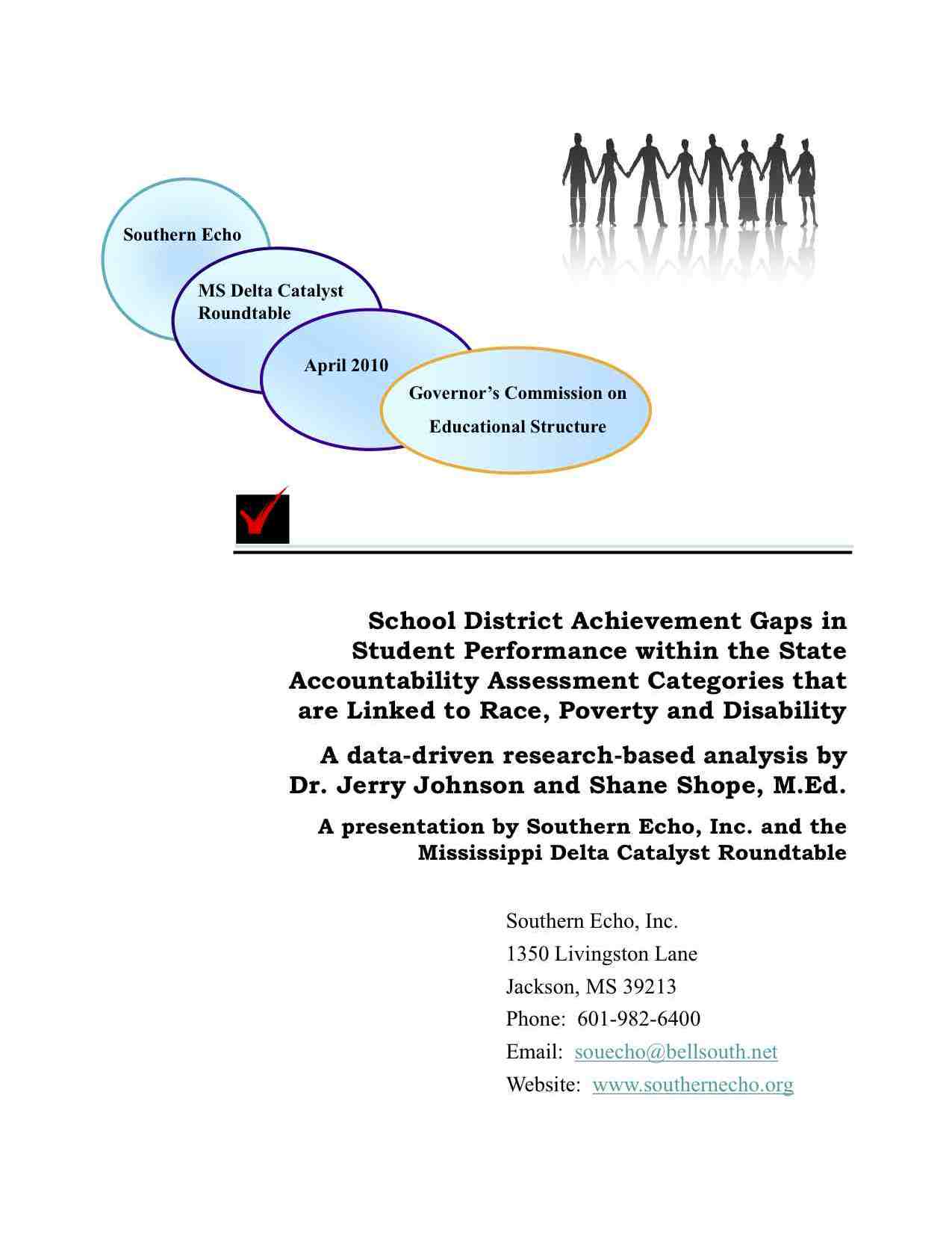 |
“School District Achievement Gaps in Student Performance with the State Accountability Assessment Categories that are Linked to Race, Poverty and Disability, a Data-Driven Research-Based Analysis”, by Dr. Jerry Johnson and Shane Shope, M.Ed., a presentation by Southern Echo, Inc. and the Mississippi Delta Catalyst Roundtable This study demonstrates that when race, poverty and student disability are accounted for the achievement gaps between higher and lower performing students similarly situated in the larger schools are equal to or greater in virtually every grade than they in the smaller schools. This study by Dr. Johnson and Mr. Shope, of the Rural Schools and Community Trust, was commissioned by Southern Echo for presentation to the (MS) Governor’s Commission on Educational Structure April 19, 2010. The study shows that the notion that in Mississippi merging smaller schools into larger schools as a means of improving student performance is not supported by the data-driven research-based evidence. |
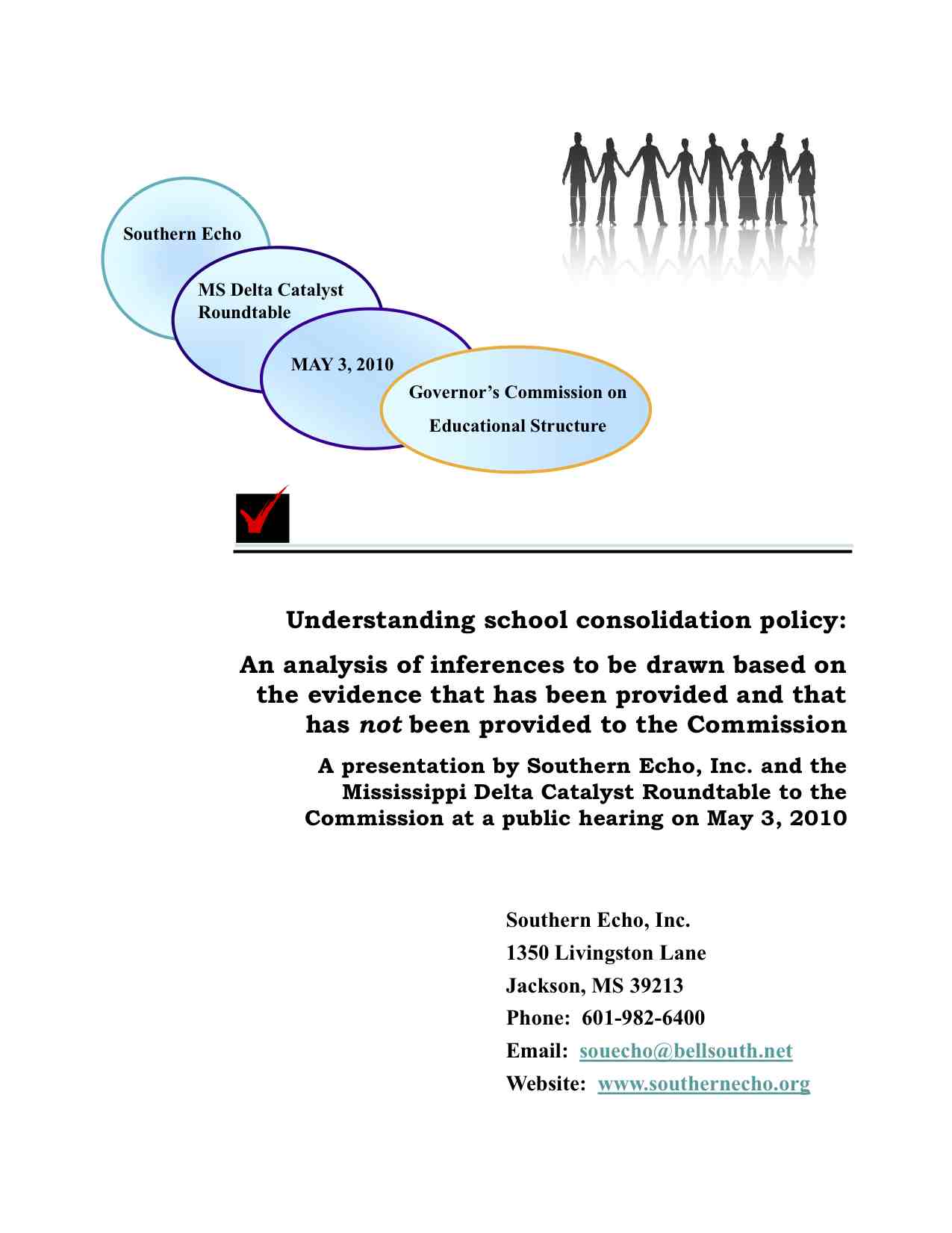 |
“Understanding school consolidation policy: An analysis of inference to be drawn based on the evidence that has been provided and that has not been provided to the Commission”, A presentation by Southern Echo and the Mississippi Delta Catalyst Roundtable to the Commission at a public hearing on May 3, 2010 This presentation summarizes the original research commissioned by and presented to the Commission by Southern Echo and the MS Delta Catalyst Roundtable. It dissects and analyzes the research and analysis presented to the Commission by its consultant, Augenblick and Palaich and discusses the data withheld by Augenblick & Palaich from the Commission and the public at the request of the Commission. The report also presents a community-based response and perspective regarding school consolidation, school elimination and the targeting of low-wealth, underperforming majority black school districts recommended to and being considered by the Governor’s Commission on Educational Structure. |
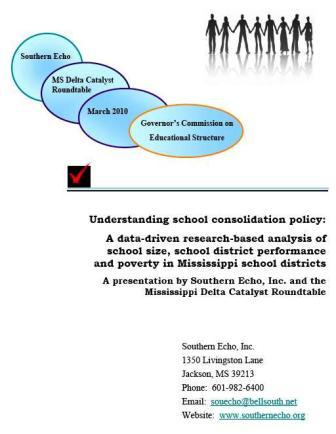 |
04-02-10 Southern Echo and MS Delta Catalyst Roundtable Report to the Governor’s Commission on MS Educational Structure (ie school consolidation) Southern Echo and the MS Delta Catalyst Roundtable, with the invaluable assistance of Dr. Jerry Johnson and Dr. Brian Lipsett, prepared a research-based data-driven analysis of school consolidation issues in Mississippi to demonstrate that the power of poverty to negatively influence student performance on standardized testing is statistically significant. but that the impact of school size on student performance is not. The Echo-Roundtable Report to the Governor’s school consolidation commission is intended to rebut policy benchmarks recommended to the Commission by its consultant, which focused on the apparent correlation between school size and underperforming schools, but which analysis did not account for poverty. |
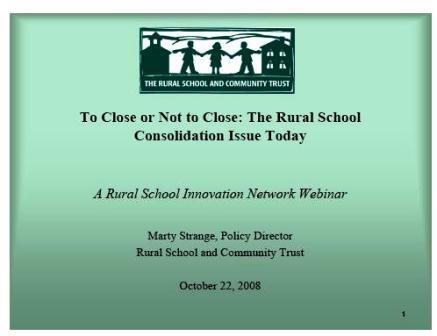 |
10-22-08 Marty Strange, Rural Schools and Community Trust — Presentation on School Consolidation This presentation lifts up the many arguments for and against school consolidation and provides data and analysis through which to understand the reality of what actually occurs when school consolidation is undertaken. |
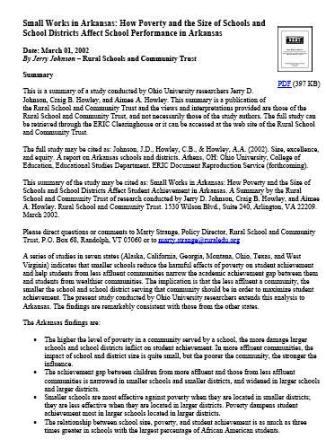 |
03-01-02 Dr. Jerry Johnson, Rural Schools and Community Trust – Small Works in Arkansas This is a short summary of a paper by the same name that presents data and analysis to demonstrate that in Arkansas the smaller schools and smaller school districts better meet the academic and personal needs of low-wealth students than larger schools and larger school districts. Mississippi is also a very rural and low-wealth state whose public school students come primarily from very rural communities and 65 percent of whom quality for free or reduced lunch, which is used by the federal government to assess poverty levels in school districts. |
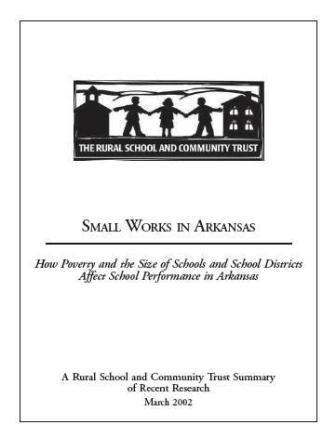 |
March 2002 – Dr. Jerry Johnson, Rural Schools and Community Trust – Small Works in Arkansas – How Poverty and the Size of Schools and School Districts Affect School Performance in Arkansas This is the full paper that presents data and analysis to demonstrate that in Arkansas the smaller schools and smaller school districts better meet the academic and personal needs of low-wealth students than larger schools and larger school districts. |
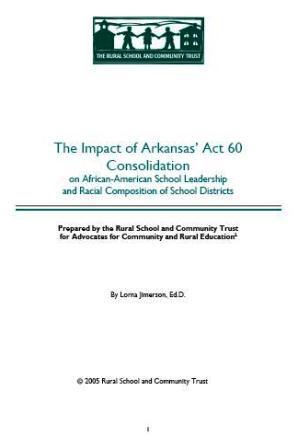 |
2005 Rural Schools and Community Trust – The Impact on Race of School Consolidation in ARKANSAS – FULL REPORT This is the full 2005 Report by Lorna Jimerson, Ed.D.,, of the Rural Schools and Community Trust that is formally entitled, “The Impact of Arkansas’ Act 60 Consolidation on African-American School Leadership and Racial Composition of School Districts”. The Report documents the disproportionate adverse impact of school consolidation in Arkansas on school districts with a majority of African American students, and on the African-American superintendents and administrators. |
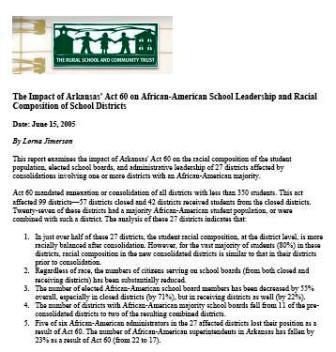 |
2005 Rural Schools and Community Trust – The Impact on Race of School Consolidation in ARKANSAS – SUMMARY This is the summary of the 2005 Report by Lorna Jimerson, Ed.D.,, of the Rural Schools and Community Trust, is formally entitled, “The Impact of Arkansas’ Act 60 Consolidation on African-American School Leadership and Racial Composition of School Districts”. The summary highlights the data that documents the disproportionate adverse impact of school consolidation in Arkansas on school districts with a majority of African American students, and on the African-American superintendents and administrators. |
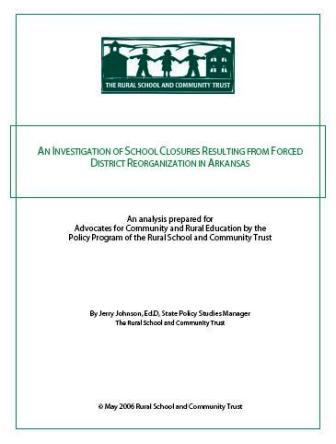 |
2006 Rural Schools and Community Trust – The Impact in ARKANSAS of Forced School Consolidation – FULL REPORT This is the full 2006 Report by Jerry Johnson, Ed.D.,, of the Rural Schools and Community Trust that is formally entitled, “An Investigation of School Closures Resulting from Forced District Reorganization in Arkansas”. The Report documents that the Arkansas forced consolidation process was carried out primarily by annexation of one district by another, that it resulted in the closing of individual schools as well as districts, that it disproportionately impacted low-wealth and majority-black school districts, and that this process disproportionately impacted school districts and schools in the Mississippi Delta region of Arkansas. |
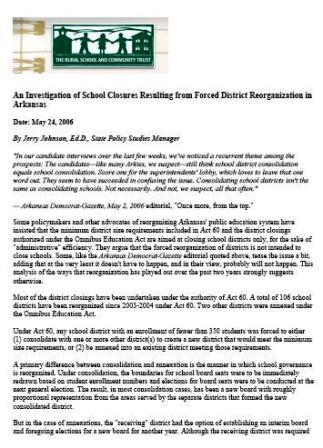 |
2006 Rural Schools and Community Trust – The Impact in ARKANSAS of Forced School Consolidation – SUMMARY This is the summary of the 2006 Report by Jerry Johnson, Ed.D.,, of the Rural Schools and Community Trust that is formally entitled, “An Investigation of School Closures Resulting from Forced District Reorganization in Arkansas”. The summary highlights the data that documents that the Arkansas forced consolidation process was carried out primarily by annexation of one district by another, that it resulted in the closing of individual schools as well as districts, that it disproportionately impacted low-wealth and majority-black school districts, and that this process disproportionately impacted school districts and schools in the Mississippi Delta region of Arkansas. |
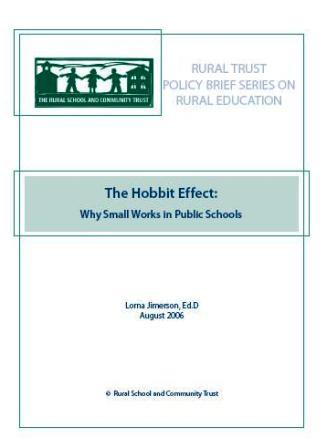 |
August 2006 – Lorna Jimerson, Ed.D, Rural Schools and Community Trust, “Why Small Works in Public Schools” – FULL REPORT This study documents the key academic and other benefits to students and community that result from preserving smaller schools, rather than eliminating them and sending students to larger consolidated schools. |
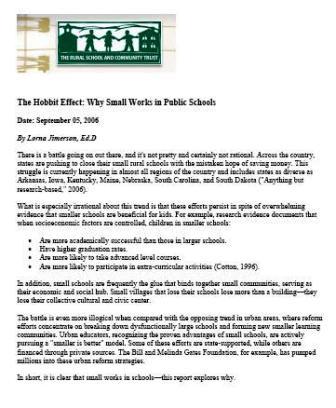 |
Sept. 5, 2006 – Lorna Jimerson, Ed.D, Rural Schools and Community Trust, “Why Small Works in Public Schools” – SUMMARY OF REPORT This Summary highlights the key academic and other benefits to students and community documented in the study that result from preserving smaller schools, rather than eliminating them and sending students to larger consolidated schools. |

